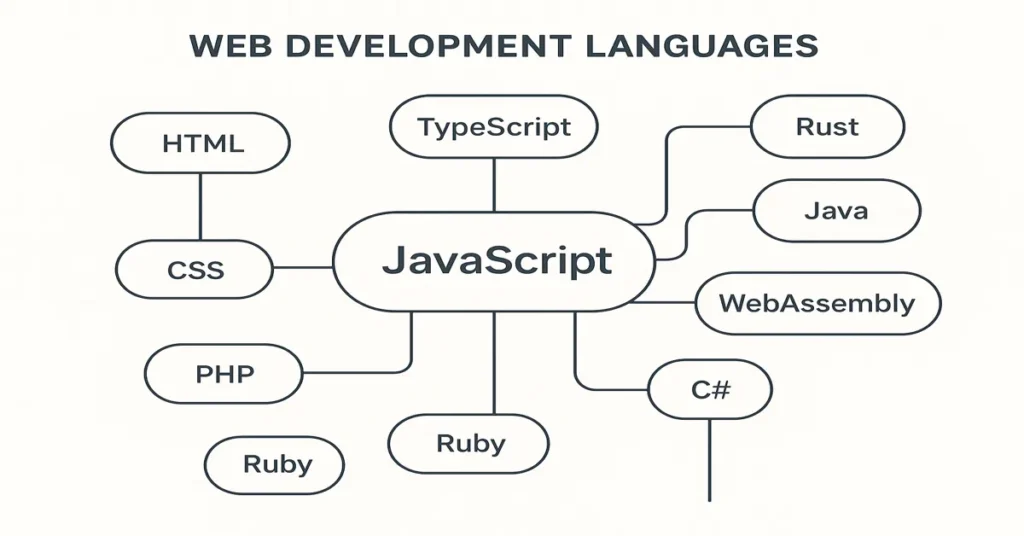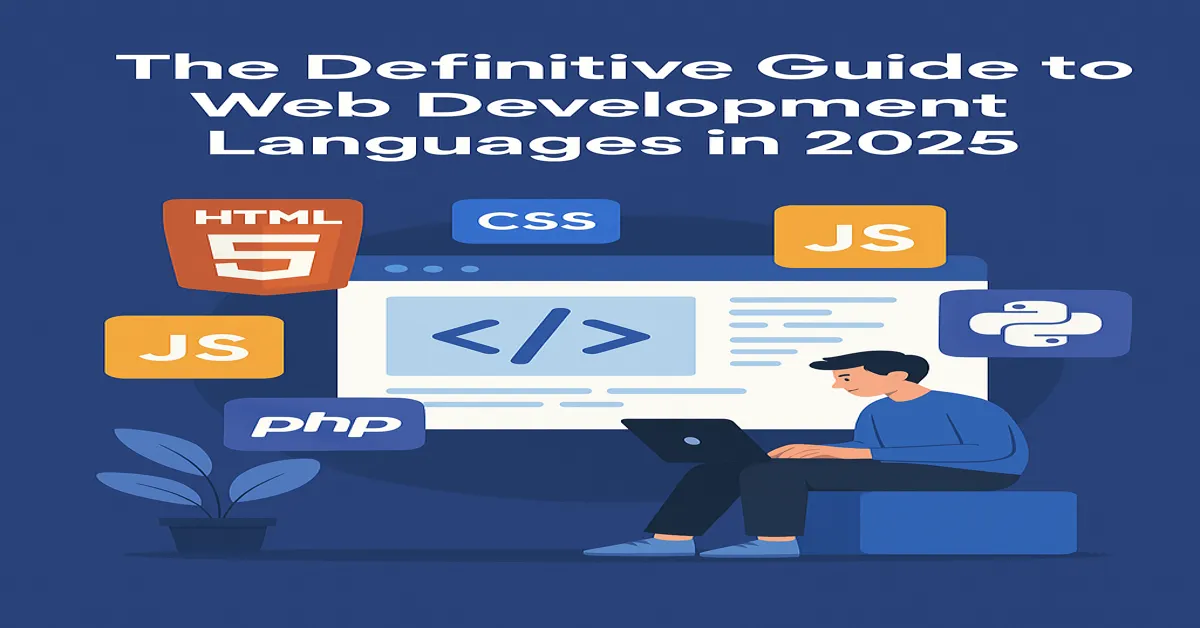In the dynamic and ever-evolving world of technology, the language in which the internet speaks has undergone continuous transformation. Web development, once a simple affair of static pages and basic scripts, is now a complex, multi-layered discipline encompassing a diverse array of languages. These programming and scripting languages power everything from interactive front-end designs to secure, scalable back-end infrastructures. As of 2025, the landscape of web development languages has not only matured but also shifted in response to new trends in AI, cybersecurity, and user experience expectations.
This article provides a comprehensive guide to the major languages that dominate web development today, examining their histories, primary uses, strengths, and the nuanced ways they’re influencing the future of the internet. This isn’t a nostalgic walk through HTML’s birth or a generic rundown of top ten lists. Instead, it is an up-to-date, analytical overview rooted in real-world application and forward-looking trends.

1. JavaScript: The Ubiquitous Workhorse
No discussion of web development languages is complete without JavaScript. Initially launched in 1995, JavaScript has evolved into the backbone of client-side web development. But in 2025, it’s far more than a browser-side scripting language.
Why JavaScript Still Leads:
- Versatility: From front-end frameworks like React and Vue to back-end environments like Node.js, JavaScript covers the full stack.
- Community & Ecosystem: With one of the largest open-source communities, there’s virtually no problem you can’t find a library or plugin for.
- Performance Improvements: Modern engines like V8 continue to optimize execution speed, keeping JavaScript competitive in performance.
- Full-Stack Integration: The rise of serverless architectures and headless CMSs has only reinforced JavaScript’s role in rapid development.
Emerging Trends:
In 2025, JavaScript is tightly integrated with AI-driven user interfaces, using machine learning to personalize interactions. Its synergy with WebAssembly is also allowing high-performance applications traditionally reserved for native environments.
2. TypeScript: JavaScript’s Smarter Sibling
Born out of JavaScript’s limitations, TypeScript has become essential in large-scale applications where type safety and maintainability matter.
Key Strengths:
- Type Annotations: Helps prevent bugs and makes code more predictable.
- Better Tooling: Provides a superior developer experience with intelligent code completion and real-time error detection.
- Growing Adoption: Enterprises and open-source projects increasingly prefer TypeScript for its ability to scale codebases safely.
In 2025, most JavaScript-based projects begin their lives in TypeScript, with developers appreciating its balance between flexibility and structure.
3. Python: The Power of Simplicity
Though not traditionally a front-end language, Python’s role in web development has expanded dramatically, particularly in back-end services and data-rich applications.
Why Python Matters:
- Frameworks Like Django and Flask: Enable rapid development of secure, scalable web apps.
- Data Science Integration: Web applications increasingly require data analysis, machine learning, or automation—all Python strongholds.
- Readable Syntax: Its simplicity makes it accessible, and its capabilities make it powerful.
As of 2025, Python-based web applications frequently serve AI and ML dashboards, real-time analytics platforms, and back-end services for IoT applications.
4. HTML, CSS & Web Standards: The Essential Triad
While not programming languages in the strict sense, HTML and CSS remain indispensable. They define structure and style, respectively.
Evolving Standards:
- CSS Variables and Grid Layouts: Offer responsive, modern design capabilities.
- HTML5 APIs: Enable advanced interactions, including offline support, multimedia, and more.
- Accessibility Improvements: Increasingly required by regulation, driving refinement in HTML standards.
In 2025, semantic HTML and accessible design are not just best practices—they’re non-negotiables.
5. Go (Golang): The Silent Performer
Created at Google, Go was built for concurrency and performance, and it’s showing significant traction in web development.
Highlights:
- High Performance: Compiled language with fast execution.
- Built-in Concurrency: Ideal for applications with many simultaneous users.
- Minimalist Syntax: Encourages clean, readable code.
Go is often behind modern APIs, microservices, and scalable back-end systems, thanks to its lightweight nature and excellent concurrency model.
6. Rust: Safety Meets Speed
Rust is emerging as a formidable choice for web developers who prioritize performance and memory safety.
Advantages:
- Memory Safety: Eliminates entire classes of bugs at compile-time.
- WebAssembly Compatibility: Brings near-native speed to the browser.
- Growing Ecosystem: With frameworks like Rocket and Actix, Rust is web-ready.
In 2025, Rust is increasingly used for performance-critical applications such as financial systems, real-time collaboration tools, and complex simulations.
7. PHP: Reinvented, Not Retired
Often dismissed as outdated, PHP continues to power over 75% of websites, and modern PHP is a different beast from its early iterations.
What’s New:
- Laravel Framework: Drives elegant, testable, and maintainable code.
- Improved Performance: PHP 8 and beyond offer JIT compilation and strong typing.
- Large Developer Base: Still one of the most widely known languages.
In the WordPress-driven and small-business ecosystems, PHP remains invaluable, especially with its revitalized performance and cleaner syntax.
8. Ruby: Elegant But Niche
Ruby, particularly through Rails, revolutionized rapid application development. However, it now serves more specific roles.
Strengths:
- Developer Happiness: Emphasis on convention over configuration.
- Rails Ecosystem: Still supports fast MVP development.
- Readable Code: Maintains a highly expressive syntax.
In 2025, Ruby is often used for prototyping, legacy systems, and startups aiming for speed-to-market rather than scale-first engineering.
9. Kotlin & Swift (Web-Adjacent Languages)
While Kotlin (Android) and Swift (iOS) are primarily mobile languages, their presence in cross-platform web development is growing.
Bridging Web and Mobile:
- Kotlin Multiplatform: Allows sharing code across web, mobile, and desktop.
- Swift for WebAssembly: An emerging use case in Apple ecosystem integrations.
In 2025, seamless user experience across devices often involves these languages as part of broader hybrid development strategies.
10. SQL & GraphQL: The Data Layer
No web application can function without data, and languages that query and manipulate that data are foundational.
SQL:
- Structured Queries: Still the most robust and predictable way to interact with relational databases.
- Mature Tooling: Advanced IDEs, optimization tools, and monitoring support.
GraphQL:
- Flexible Queries: Allows clients to request exactly what they need.
- Great for APIs: Reduces over-fetching and under-fetching.
Together, these languages ensure that web applications remain data-rich, fast, and efficient.
Looking Ahead: What Will Shape the Next Five Years?
As we move beyond 2025, the languages we’ve covered will continue to evolve, but three dominant trends will shape their trajectories:
1. AI Integration:
AI won’t just be a back-end service. Languages will increasingly support AI at the syntax and library levels.
2. WebAssembly Expansion:
More languages will compile to WebAssembly, expanding browser capabilities and potentially eroding JavaScript’s monopoly on the front end.
3. Developer Experience First:
Languages and frameworks that improve onboarding, code readability, and maintainability will win in the long term.
Conclusion: Choosing the Right Language for the Job
The question isn’t which web development language is the best—it’s which one is best for your needs. Each language covered in this guide offers a different balance of performance, scalability, and usability. The polyglot developer of 2025 is not a specialist in one language, but a strategist who understands when and how to use many.
In this diverse, fast-changing ecosystem, mastery comes not from knowing every detail of every language, but from understanding the trade-offs, strengths, and contexts that inform their use. Whether you’re building a real-time multiplayer game, a secure financial dashboard, or a responsive e-commerce platform, the modern web developer’s toolkit is rich, evolving—and more exciting than ever.
FAQs
1. What is the most important web development language to learn in 2025?
Answer: JavaScript remains the most essential language in 2025 due to its full-stack capabilities, broad ecosystem, and widespread use in modern frameworks like React, Node.js, and Vue. However, combining JavaScript with TypeScript enhances code safety and maintainability, making the duo highly recommended.
2. How is WebAssembly changing the web development language landscape?
Answer: WebAssembly (Wasm) allows languages like Rust, C++, and Swift to run in the browser with near-native performance. This is expanding the web’s capabilities beyond JavaScript, enabling developers to build complex applications like games, simulations, and data visualization tools directly in the browser.
3. Is PHP still relevant for modern web development?
Answer: Yes, PHP remains relevant, especially with the modern features in PHP 8+ and robust frameworks like Laravel. It’s widely used in content management systems (CMS) like WordPress and continues to power a significant portion of the web, particularly for small to medium-sized applications.
4. Which languages are best suited for integrating AI into web applications?
Answer: Python is the leading language for integrating AI due to its strong ecosystem in machine learning (TensorFlow, PyTorch) and data science. JavaScript is also gaining ground in AI at the front end, especially for creating dynamic, personalized user experiences with TensorFlow.js.
5. What role does TypeScript play in large-scale web applications?
Answer: TypeScript provides static typing to JavaScript, making it easier to scale applications and catch bugs early in development. It’s especially valuable in enterprise environments where long-term maintainability and team collaboration are critical.











